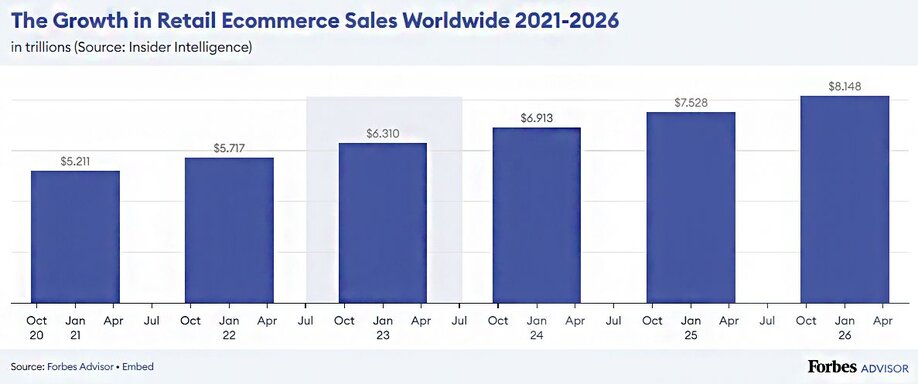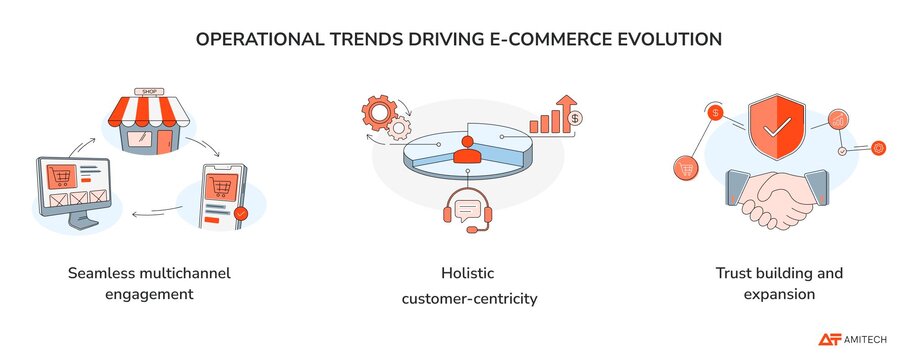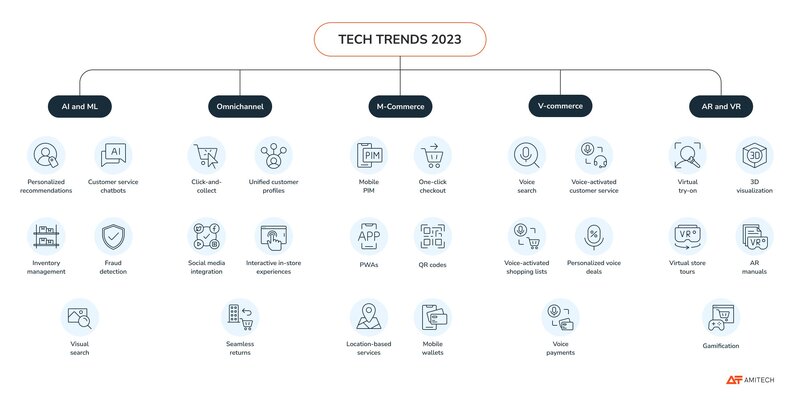Blog post
Analytics
🕒 10 min
The Future of eCommerce: Challenges, Opportunities, and Strategic Advice
The market is to double by 2026, but many businesses are missing out on the vast potential, recent research says. Learn what eCommerce trends will drive the industry and how to adapt

eCommerce post-pandemic state: the present and beyond
The eCommerce industry witnessed an unprecedented boom in 2020, hitting major challenges in the following years. This involved supply chain disruptions, rapidly evolving customer demand, and increased competition. Despite this, the eCommerce market has been steadily growing each year by 12%, expecting retail sales to almost double by 2026. However, companies still struggle to capitalize on the expanding opportunities.

eCommerce growth 2020–2025 (Image credit)
The problem is that many companies view eCommerce as a simple add-on to the core business. This perspective downplays the eCommerce potential in propelling digital initiatives that lead to customer satisfaction, optimized operations, and a sales boost. The trend has it that an effective transition to the next eCommerce level requires adopting a customer-first approach coupled with new technology and agile methodologies. The transformation is often followed by some tough decisions, though.
This blog post explores recent eCommerce trends that drive the industry and looks into effective strategies to help tailor operations accordingly.
What the next digital commerce frontier brings
Let’s dive into the aspects defining the present state of eCommerce.
Seamless multichannel engagement
The surge in digital channels, from live commerce to metaverse, demands a cohesive approach. Instead of treating each channel in isolation, companies opt for a headless eCommerce strategy. So you can sell wherever your customers engage, providing consistent experiences across multiple touchpoints without operational constraints.

Operational trends in eCommerce
Holistic customer-centricity
Instead of focusing on solely building features and increasing sales, businesses are transitioning to comprehensive solutions. This shift involves in-depth research into customer behaviors, and then offering services that tackle a broad spectrum of customer concerns.
Trust building and expansion
Venturing into new markets and expanding services requires solid customer trust. Smart strategies, such as user-friendly digital sales, secure payments, or customer protection services can help sail through this initiative.
How to navigate: the tough decisions
Embarking on the transformation journey demands introspection and resolute decision-making. Unlike the relatively familiar scenario of adopting newer technology, developing a customer-first approach and trust building presents a more intricate challenge. While promising, the idea of customer-centricity is often compromised, due to stakeholder agendas, internal company politics, and short-term financial considerations.
Ever wonder how to navigate the journey, balancing the opportunities and potential obstacles? Take a look at the following ideas.
Recognizing profitability blind spots
Shifting focus from revenue to profit leads to understanding customer values. As a result, you provide distinctive offerings, while also streamlining operational efficiency to safeguard margins.
Fostering the agile culture
Assembling a team of action-oriented professionals who embrace experimentation and customer-centricity is pivotal. Employ data-driven insights for informed decision-making and calculate risks.
Aligning operations with customer outcomes
Revamp your tech organization to bring about innovation. It may involve switching from legacy systems to the MACH architecture, facilitating integrations via flexible APIs, improving user experience, etc. By intertwining IT objectives with customer demand and profitability metrics, you pave the way for strategic progress.
Promoting cross-functional collaboration
Establish in-house teams that coordinate efforts and deliver business-critical outcomes. Introduce incentives and performance measurements that champion customer-centric actions across departments.
The eCommerce landscape evolves at breakneck speed, and the success goes beyond sales figures. It rests upon strategic transformation, with businesses prioritizing their customers and leveraging digital opportunities. Understanding these driving forces and making the necessary challenging choices helps businesses reach the new operational level, spearheading innovation and growth.
eCommerce tech trends that spark opportunities
By aligning operational strategies and emerging technology trends, you can lay a solid groundwork for your business. Let’s see what the future of online commerce brings.
Artificial Intelligence (AI) and machine learning
AI-driven eCommerce personalization enhances customer experiences by tailoring recommendations and content. With machine learning in place, you can analyze user behavior, aiding in predictive analytics and efficient inventory management. In addition, customer service chatbots handle routine inquiries, minimizing human effort.
Generative AI and natural language can now revolutionize how the retail industry operates. For example, an online retailer can save hours or even days on manual product catalog creation. With ChatGPT for image recognition, you can easily analyze product labels and automatically generate item descriptions based on that. Also, see how Amazon envisions Generative AI for software development, personalized content creation, and other tasks.
M-commerce. Optimizing mobile experiences is crucial for tapping into this expanding market. For instance, Mobile PIM (Product Information Management) systems streamline product management across various platforms, ensuring consistent and up-to-date information for both administrators and customers.
Furthermore, one-click checkout options simplify the purchasing process, reducing friction and enhancing convenience. QR Codes, on the other hand, facilitate easy access to products and special promotions, enriching user engagement. Additionally, integration with mobile wallets allows for faster and more secure payments.
Technical trends in eCommerce
Omnichannel experience
Seamlessly connecting online and offline experiences provides customers with consistent interactions across touchpoints, enhancing their journey.
For example, Bold Commerce has launched a headless checkout integration in collaboration with PayPal. The integration offers brands using Adobe Commerce a composable and optimized checkout experience without the need for complex replatforming. This means that companies can design a unique checkout process by choosing and arranging different steps that work best for their customers, all without completely changing the existing system.
Voice commerce
The technology enables purchasing via voice commands, providing a seamless and modern shopping experience. As such, eBay employed Google Assistant to enable voice querying right within the mobile app.
Augmented reality (AR) and virtual reality (VR)
AR and VR offer an immersive experience by enabling virtual try-ons and interactive product visualization. Here are a few successful examples of technology usage.
Ikea launched an app to virtually furnish an apartment, choosing the right furniture by size and design. Nike delivered an immersive platform for users to co-create or design virtual clothes and shoes, further using them in games or trading.
The world of tech is evolving, so staying in the loop and competing requires strategic adaptation coupled with profound technical and domain knowledge.
Update: XR (Extended Reality, including AR, VR, and MR) may have been all the buzz in recent years, but it's not leading the pack for 2025 eCommerce trends—especially in B2B. Instead, businesses are prioritizing strategies that emphasize operational efficiency, customer-centric innovations, flexible and scalable technology solutions, and seamless integration of digital and self-service experiences.
But hey, don’t just take our word for it! Dive into our latest insights and predictions to stay ahead of the curve in B2B eCommerce for 2025.
How to navigate: practical advice
In this section, our technology experts share their take on the eCommerce advancements from the architectural perspective. The insights delve deeper into patterns and best practices that help to bridge technology and eCommerce.

What architectural patterns do you believe are crucial today for building modern and scalable eCommerce systems?

“The modern landscape of eCommerce demands intelligent architectural decisions that balance performance and user experience. Implementing patterns like server-side rendering optimizes website loading times, utilizing edge computing ensures quick data delivery, and leveraging JavaScript judiciously minimizes client-side processing—all enhancing the user's journey. Embracing microservices, event sourcing, and message broker architecture guarantees scalability and streamlined system management.”


To stay current with trends and customer demand businesses seek to introduce new functionality. How do you balance the need for flexibility and stability in your architecture?

“As software systems evolve, eCommerce developers walk a fine line between flexibility and stability. For example, by using elaborate feature toggling, you can provide users with only the essential functions they need at a given moment. This approach allows for managing resources effectively and optimizes the user experience”.


“It's a constant juggling act: introducing new features while ensuring everything runs seamlessly. As each new feature comes in, the system faces increased loads and complexity. But fear not, we employ hands-on and automated tests to ensure stability. This way, you enjoy a seamless user experience even as the under-the-hood magic adds up.”


How do you stay up-to-date with evolving security best practices and compliance standards?

“Adhering to security frameworks and eliminating vulnerabilities during development establishes a robust foundation. As for architecture, regularly updating software dependencies protects systems from evolving threats. Prioritizing security and legal compliance from the outset of development minimizes risks and safeguards sensitive customer data.”


Headless commerce is all the rage nowadays. What are the benefits and challenges of adopting a headless eCommerce approach?

“The headless technology offers multiple benefits. One of these is customizability which lets you control every detail of your admin panel or storefront.
Another benefit is a decoupled architecture. For example, you have a back end (APIs) and a front end (a storefront, an admin panel, etc.), each focusing on different tasks. Unlike the back end, the front end rapidly changes, with frameworks being replaced by newer ones and technology evolving swiftly. The brilliance is in keeping these two parts separate, allowing them to develop independently.”


“However, every journey has its bumps. A challenge arises with a lack of basic tools in headless eCommerce. Often, you're dealing only with APIs, which can be puzzling for those less into tech. Another challenge is the absence of ready-made extensions. Creating those extensions for a headless eCommerce setup can be a bit of a puzzle, and compatibility between different developments can be a real challenge to address.”


“Headless eCommerce brings a lot of perks, like better performance and lots of customization options. But, it's not all smooth sailing. You'll face things like integrating everything by yourself and dealing with different frameworks for different eCommerce platforms. On the bright side, many headless commerce providers give you handy documentation to help you out. This approach is all about flexibility and having a separate architecture, which makes everything fit together well—but that also means you'll need a good grasp of how things work.
With the right level of technical expertise and learning culture, you can timely identify the potential bottlenecks, outline the roadmap for successful implementation or improvement, and effectively support or further enhance the system based on evolving needs.”


How might emerging tech reshape the way eCommerce systems are built and operated?

“Modern software ecosystems allow for the seamless integration of emerging technologies. In one of our recent projects, we successfully implemented AI-driven functionality to enable personalized product recommendations, resulting in a significant boost in profits. Remarkably, this functionality is seamlessly integrated without impacting the existing architecture.
Additionally, cutting-edge technologies like voice commands require minimal engineering efforts while transforming the customer experience and enhancing retention rates. Recognizing the technology potential with the ability to make well-informed architectural decisions helps achieve business goals effectively”.


In the context of eCommerce trends, what lessons learned from your experience would benefit current/upcoming projects?

“The project's success lies in efficient architectural decisions. Although architecture sets the stage for evolution, adaptability, and peak performance, it is important not to overburden the system with unnecessary functionality. A common case is when companies attempt to future-proof their businesses, delivering highly scalable and resource-intensive solutions. But eventually, your business may head in a different direction, and the extensive functionality may no longer align with current needs.
The key principle is to stay agile and responsive to changing demands, so that you ensure that the architectural decisions support present objectives while being flexible enough to accommodate future shifts.”

Last updated: January 8, 2025
About the authors

Drives the team’s technical excellence like there are no barriers. Gears the race with real game-changing finds.

Has wizardly powers to magically bring in web and mobile platforms, thus breaking heavy eCommerce spells.

Adept at crafting engaging and user-friendly copy about software technology, cloud computing, and eCommerce development.
Keep track on latest trends in web
Let’s nail another market-shaking project together! While you are thinking, check out our latest ones.


